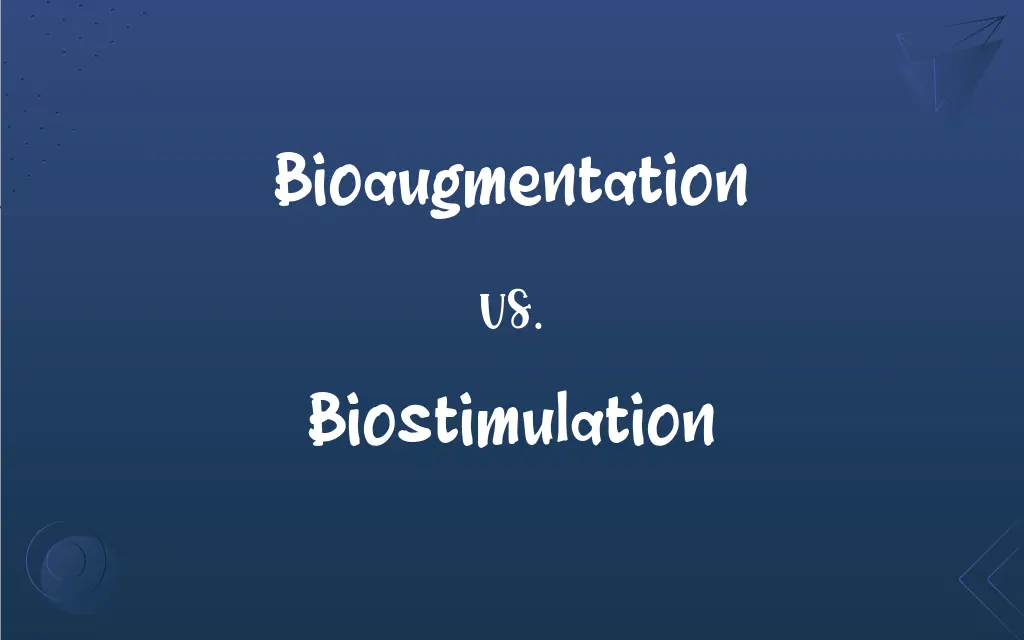Bioaugmentation vs. Biostimulation: What's the Difference?
Edited by Aimie Carlson || By Janet White || Published on February 24, 2024
Bioaugmentation involves adding specific microorganisms to degrade pollutants, while biostimulation enhances existing microbial activity to accelerate degradation.

Key Differences
Bioaugmentation is the process of adding selected, cultured microorganisms to contaminated environments to break down pollutants. Biostimulation, on the other hand, focuses on stimulating the existing microbial population in the environment by providing nutrients or altering conditions.
The goal of bioaugmentation is to introduce microorganisms with specific degradation capabilities that might be absent in the contaminated site. Biostimulation aims to enhance the metabolic activity of the indigenous microbial community to accelerate pollutant degradation.
Bioaugmentation requires a detailed understanding of the contaminant and the suitable microorganisms capable of degrading it. Biostimulation, however, often involves adjusting environmental factors like pH, temperature, or oxygen levels to optimize conditions for existing microbes.
In bioaugmentation, the success depends on the survival and activity of the introduced microbes in the new environment. In contrast, biostimulation's effectiveness relies on the existing microbial community’s response to the improved conditions.
Bioaugmentation is often used when biostimulation alone is insufficient to degrade complex pollutants. Biostimulation is generally preferred when the existing microbial population is capable but requires optimization of environmental conditions.
ADVERTISEMENT
Comparison Chart
Method
Adding specific microorganisms
Enhancing activity of existing microbes
Focus
Introducing degradation capabilities
Optimizing environmental conditions
Dependency
Relies on introduced microorganisms' survival
Depends on indigenous microbial response
Application
Used for complex pollutants
Preferred for responsive microbial populations
Environmental Adjustment
Not primarily focused
Involves adjusting pH, temperature, nutrients, etc.
ADVERTISEMENT
Bioaugmentation and Biostimulation Definitions
Bioaugmentation
Bioaugmentation: A tool for environmental biotechnology.
Bioaugmentation is a key strategy in modern environmental cleanup.
Biostimulation
Biostimulation: Encouraging indigenous microbial growth and activity.
The biostimulation process helped in cleaning the polluted river.
Bioaugmentation
Bioaugmentation: Adding microorganisms to degrade pollutants.
The company used bioaugmentation to clean the oil-contaminated soil.
Biostimulation
Biostimulation: Stimulating microbial activity in contaminated areas.
Biostimulation was used to enhance the natural biodegradation process.
Bioaugmentation
Bioaugmentation: Introducing specific bacteria for bioremediation.
Bioaugmentation was employed to treat the industrial wastewater.
Biostimulation
Biostimulation: Involves optimizing environmental conditions for microbes.
Adjusting nutrient levels was part of the biostimulation strategy.
Bioaugmentation
Bioaugmentation: Enhancing degradation in contaminated sites.
Bioaugmentation sped up the breakdown of toxins in the lake.
Biostimulation
Biostimulation: A technique for accelerating natural bioremediation.
Biostimulation was effective in the groundwater treatment project.
Bioaugmentation
Bioaugmentation: Involves cultured microorganisms for specific pollutants.
For heavy metal removal, bioaugmentation was the chosen method.
Biostimulation
Biostimulation: Enhances degradation by providing nutrients.
By adding phosphorus, the biostimulation process was initiated.
Bioaugmentation
The use of microorganisms to help decompose pollutants
Biostimulation
(biology) The stimulation of a system's existing bacteria such that they can have a remedial action.
FAQs
When is bioaugmentation typically used?
Bioaugmentation is used in situations where specific contaminants require targeted microbial degradation.
Can bioaugmentation and biostimulation be used together?
Yes, bioaugmentation and biostimulation can be combined for more effective bioremediation.
What is the main purpose of bioaugmentation?
The main purpose of bioaugmentation is to add specific microorganisms to degrade environmental pollutants.
What types of environmental adjustments are made in biostimulation?
Biostimulation involves adjustments like altering pH, temperature, and adding nutrients to stimulate microbial growth.
What factors influence the effectiveness of biostimulation?
The effectiveness of biostimulation is influenced by the nature of the contaminant, the existing microbial community, and the environmental conditions.
Are there risks associated with bioaugmentation?
Risks include potential impacts on native microbial communities and the broader ecosystem.
How does biostimulation work?
Biostimulation works by enhancing the existing microbial activity in an environment to accelerate pollutant degradation.
How is the success of bioaugmentation measured?
The success of bioaugmentation is measured by the reduction or elimination of the target pollutants.
What kind of pollutants is bioaugmentation most effective against?
Bioaugmentation is most effective against complex organic compounds and specific pollutants like certain pesticides or hydrocarbons.
Is biostimulation a cost-effective method for bioremediation?
Biostimulation is often cost-effective, especially when indigenous microbes are capable of degrading the pollutant.
What are the challenges of bioaugmentation?
Challenges of bioaugmentation include ensuring the survival and activity of introduced microorganisms in a new environment.
Is biostimulation effective for all types of pollutants?
Biostimulation is effective for pollutants that the indigenous microbial population can degrade, but not all pollutants.
How is the progress of biostimulation monitored?
Progress is monitored by measuring changes in contaminant levels, microbial populations, and environmental parameters.
Can biostimulation be used in marine environments?
Yes, biostimulation can be used in various environments, including marine settings.
Can bioaugmentation be used for soil remediation?
Yes, bioaugmentation is frequently used for soil remediation.
Is biostimulation a long-term solution for pollution?
Biostimulation can offer long-term benefits, but its sustainability depends on continuous optimal conditions.
How does biostimulation affect the biodiversity of a site?
Biostimulation can enhance biodiversity by promoting the growth of beneficial microbes.
Can bioaugmentation address heavy metal contamination?
Certain bioaugmentation approaches can address heavy metal contamination by using microbes that can immobilize or transform these metals.
What are common sources of microorganisms used in bioaugmentation?
Common sources include specially cultured strains from laboratories or environmental isolates known for their degradation capabilities.
Are there regulatory concerns with using bioaugmentation?
Yes, regulatory concerns include ensuring environmental safety and compliance with laws governing the release of genetically modified or non-native organisms.
About Author
Written by
Janet WhiteJanet White has been an esteemed writer and blogger for Difference Wiki. Holding a Master's degree in Science and Medical Journalism from the prestigious Boston University, she has consistently demonstrated her expertise and passion for her field. When she's not immersed in her work, Janet relishes her time exercising, delving into a good book, and cherishing moments with friends and family.
Edited by
Aimie CarlsonAimie Carlson, holding a master's degree in English literature, is a fervent English language enthusiast. She lends her writing talents to Difference Wiki, a prominent website that specializes in comparisons, offering readers insightful analyses that both captivate and inform.
































































